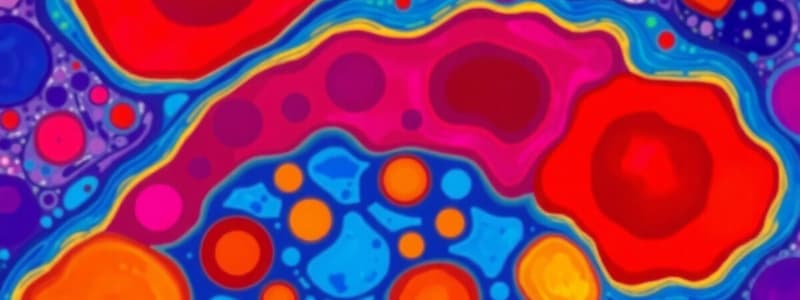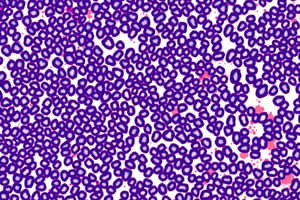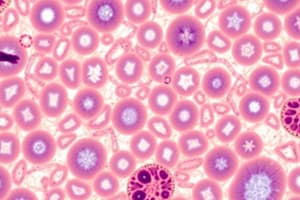Podcast
Questions and Answers
What type of tissue primarily forms protective barriers in the body?
What type of tissue primarily forms protective barriers in the body?
- Epithelial Tissue (correct)
- Muscle Tissue
- Connective Tissue
- Nervous Tissue
Which type of epithelial tissue is characterized by multiple layers of cells?
Which type of epithelial tissue is characterized by multiple layers of cells?
- Simple Epithelium
- Stratified Epithelium (correct)
- Pseudostratified Epithelium
- Transitional Epithelium
What function of epithelial tissue involves nutrient uptake in the digestive tract?
What function of epithelial tissue involves nutrient uptake in the digestive tract?
- Absorption (correct)
- Protection
- Secretion
- Filtration
Which connective tissue type is responsible for transporting gases and nutrients in the body?
Which connective tissue type is responsible for transporting gases and nutrients in the body?
What is a key characteristic of connective tissue?
What is a key characteristic of connective tissue?
In which type of tissue would you find cells that detect stimuli?
In which type of tissue would you find cells that detect stimuli?
Which type of epithelial tissue appears stratified but has all cells in contact with the basement membrane?
Which type of epithelial tissue appears stratified but has all cells in contact with the basement membrane?
The primary function of adipose tissue is to:
The primary function of adipose tissue is to:
Which type of connective tissue specifically supports organs and blood vessels?
Which type of connective tissue specifically supports organs and blood vessels?
What is the primary function of skeletal muscle tissue?
What is the primary function of skeletal muscle tissue?
Which type of muscle tissue is specifically found in the heart?
Which type of muscle tissue is specifically found in the heart?
What type of tissue is primarily responsible for transporting oxygen and nutrients?
What type of tissue is primarily responsible for transporting oxygen and nutrients?
What is the primary function of connective tissue?
What is the primary function of connective tissue?
What structure in neurons is responsible for receiving signals?
What structure in neurons is responsible for receiving signals?
Which one of the following is a function of muscle tissue?
Which one of the following is a function of muscle tissue?
Which type of tissue is considered the most rigid connective tissue?
Which type of tissue is considered the most rigid connective tissue?
Where is transitional epithelium primarily located?
Where is transitional epithelium primarily located?
What role do osteoblasts play in bone tissue?
What role do osteoblasts play in bone tissue?
What type of connective tissue provides strength and resistance to stretching?
What type of connective tissue provides strength and resistance to stretching?
What type of connective tissue connects muscle to bone?
What type of connective tissue connects muscle to bone?
Which component of bone tissue provides its hardness and strength?
Which component of bone tissue provides its hardness and strength?
What is a characteristic feature of glandular epithelium?
What is a characteristic feature of glandular epithelium?
What is the primary role of glial cells in nervous tissue?
What is the primary role of glial cells in nervous tissue?
Which type of epithelium is characterized by cells that change shape when stretched?
Which type of epithelium is characterized by cells that change shape when stretched?
Where are osteocytes located within the bone tissue?
Where are osteocytes located within the bone tissue?
Which type of bone is characterized by being organized into units called osteons?
Which type of bone is characterized by being organized into units called osteons?
Which component of the extracellular matrix is mostly responsible for forming a thick, gel-like material?
Which component of the extracellular matrix is mostly responsible for forming a thick, gel-like material?
What distinguishes endocrine glands from exocrine glands?
What distinguishes endocrine glands from exocrine glands?
What is the primary function of osteoclasts in bone dynamics?
What is the primary function of osteoclasts in bone dynamics?
What is bone remodeling?
What is bone remodeling?
What is a key feature of epithelial tissue?
What is a key feature of epithelial tissue?
What do canaliculi do in bone tissue?
What do canaliculi do in bone tissue?
What is the primary function of simple squamous epithelium?
What is the primary function of simple squamous epithelium?
Which type of epithelium is described as having a single layer of irregularly shaped cells that appears stratified?
Which type of epithelium is described as having a single layer of irregularly shaped cells that appears stratified?
Where is simple cuboidal epithelium typically found?
Where is simple cuboidal epithelium typically found?
What is the main characteristic of stratified epithelium?
What is the main characteristic of stratified epithelium?
What type of epithelium provides protection against physical and chemical wear?
What type of epithelium provides protection against physical and chemical wear?
Which cell shape is characterized by box-like cells that are roughly as wide as they are tall?
Which cell shape is characterized by box-like cells that are roughly as wide as they are tall?
Where is pseudostratified columnar epithelium often found?
Where is pseudostratified columnar epithelium often found?
What is a defining feature of stratified cuboidal epithelium?
What is a defining feature of stratified cuboidal epithelium?
Which type of muscle tissue is characterized by a branched structure and a single nucleus?
Which type of muscle tissue is characterized by a branched structure and a single nucleus?
What is the primary function of smooth muscle?
What is the primary function of smooth muscle?
Which nervous system regulates the contraction of cardiac muscle?
Which nervous system regulates the contraction of cardiac muscle?
What structural characteristic distinguishes skeletal muscle from cardiac muscle?
What structural characteristic distinguishes skeletal muscle from cardiac muscle?
Which of the following statements about cardiac muscle is incorrect?
Which of the following statements about cardiac muscle is incorrect?
Which type of muscle tissue is controlled by the somatic nervous system?
Which type of muscle tissue is controlled by the somatic nervous system?
What characteristic of smooth muscle can lead to confusion regarding its structure?
What characteristic of smooth muscle can lead to confusion regarding its structure?
Which function is NOT associated with smooth muscle tissue?
Which function is NOT associated with smooth muscle tissue?
Flashcards
Cartilage
Cartilage
Connective tissue that provides flexible support, found in joints, ears, and nose.
Tendon
Tendon
Connective tissue that connects muscles to bones, allowing movement.
Ligament
Ligament
Connective tissue that connects bones to bones, providing stability and support for joints.
Skeletal muscle
Skeletal muscle
Signup and view all the flashcards
Cardiac muscle
Cardiac muscle
Signup and view all the flashcards
Smooth muscle
Smooth muscle
Signup and view all the flashcards
Neurons
Neurons
Signup and view all the flashcards
Glial cells
Glial cells
Signup and view all the flashcards
Epithelial Tissue
Epithelial Tissue
Signup and view all the flashcards
Simple Epithelium
Simple Epithelium
Signup and view all the flashcards
Stratified Epithelium
Stratified Epithelium
Signup and view all the flashcards
Pseudostratified Epithelium
Pseudostratified Epithelium
Signup and view all the flashcards
Connective Tissue
Connective Tissue
Signup and view all the flashcards
Supporting Connective Tissue
Supporting Connective Tissue
Signup and view all the flashcards
Binding Connective Tissue
Binding Connective Tissue
Signup and view all the flashcards
Blood
Blood
Signup and view all the flashcards
Squamous Cells
Squamous Cells
Signup and view all the flashcards
Cuboidal Cells
Cuboidal Cells
Signup and view all the flashcards
Columnar Cells
Columnar Cells
Signup and view all the flashcards
Simple Squamous Epithelium
Simple Squamous Epithelium
Signup and view all the flashcards
Simple Cuboidal Epithelium
Simple Cuboidal Epithelium
Signup and view all the flashcards
Simple Columnar Epithelium
Simple Columnar Epithelium
Signup and view all the flashcards
Stratified Columnar Epithelium
Stratified Columnar Epithelium
Signup and view all the flashcards
Transitional Epithelium
Transitional Epithelium
Signup and view all the flashcards
Glands
Glands
Signup and view all the flashcards
Endocrine Glands
Endocrine Glands
Signup and view all the flashcards
Exocrine Glands
Exocrine Glands
Signup and view all the flashcards
Ground Substance
Ground Substance
Signup and view all the flashcards
Collagen Fibres
Collagen Fibres
Signup and view all the flashcards
What is cardiac muscle?
What is cardiac muscle?
Signup and view all the flashcards
What are intercalated discs?
What are intercalated discs?
Signup and view all the flashcards
What is skeletal muscle?
What is skeletal muscle?
Signup and view all the flashcards
What is smooth muscle?
What is smooth muscle?
Signup and view all the flashcards
What does striated mean?
What does striated mean?
Signup and view all the flashcards
What is the difference between voluntary and involuntary muscle?
What is the difference between voluntary and involuntary muscle?
Signup and view all the flashcards
What does involuntary muscle mean?
What does involuntary muscle mean?
Signup and view all the flashcards
What is "intrinsic rhythm"?
What is "intrinsic rhythm"?
Signup and view all the flashcards
Bone tissue
Bone tissue
Signup and view all the flashcards
Osteoblasts
Osteoblasts
Signup and view all the flashcards
Osteocytes
Osteocytes
Signup and view all the flashcards
Osteoclasts
Osteoclasts
Signup and view all the flashcards
Osteogenic cells
Osteogenic cells
Signup and view all the flashcards
Bone remodeling
Bone remodeling
Signup and view all the flashcards
Compact bone
Compact bone
Signup and view all the flashcards
Haversian canal
Haversian canal
Signup and view all the flashcards
Study Notes
Overview of Tissues
- Tissues are organized groups of cells with similar structures and functions
- Four main tissue types: epithelial, connective, muscle, and nervous
Epithelial Tissue
-
Structure: Tightly packed cells forming sheets that cover body surfaces, line cavities and passageways, and form glands.
-
Functions: Protection, secretion, absorption, filtration, and sensory reception.
-
Types of Epithelial Tissue:
- Simple Epithelium: One layer of cells
- Simple Squamous: Thin, scale-like cells. Ideal for diffusion, found in blood vessels and alveoli.
- Simple Cuboidal: Cube-shaped cells. Involved in secretion and absorption, found in kidneys and glands.
- Simple Columnar: Tall, column-shaped cells. Involved in secretion and absorption, found in the digestive tract.
- Pseudostratified Columnar: Appears layered but is a single layer. Involved in secretion and propulsion of mucus, found in the respiratory tract.
- Stratified Epithelium: Multiple layers of cells.
- Stratified Squamous: Multiple layers with flattened cells at the surface. Provides protection, found in the skin, mouth, etc.
- Stratified Cuboidal: Multiple layers of cube-shaped cells. Found in some glands.
- Stratified Columnar: Multiple layers with column-like cells at the surface. Rare, found in some glands.
- Transitional: Cells change shape depending on stretching. Found in the urinary bladder.
- Simple Epithelium: One layer of cells
-
Glandular Epithelium: Specialized epithelial tissue that secretes chemical substances.
- Endocrine Glands: Ductless, release hormones directly into the blood.
- Exocrine Glands : Ducts, release secretions to the outside environment (e.g., sweat glands, salivary glands).
Connective Tissue
- Structure: Contains cells scattered within an extracellular matrix (ECM) composed of fibers and ground substance.
- Functions: Support, connection, protection, transport, and storage.
- Types of Connective Tissue:
- Loose Connective Tissue (e.g., areolar, adipose, reticular):
- Areolar: Supports organs, cushioning
- Adipose: Stores fat, insulation
- Reticular: Provides a framework for soft organs
- Dense Connective Tissue (e.g., tendons, ligaments):
- Dense Regular: Collagen fibers arranged parallel, providing strength (e.g., tendons)
- Dense Irregular: Collagen fibers arranged randomly, providing strength in multiple directions (e.g., dermis of skin)
- Cartilage:
- Hyaline: Most common type, provides support and flexibility (e.g., trachea, nose, joints)
- Elastic: Provides support and elasticity (e.g., ear)
- Fibrocartilage: Very tough, provides support and shock absorption (e.g., intervertebral discs, knee meniscus)
- Bone: Provides support and protection, stores minerals
- Blood: Transports substances, immunity
- Loose Connective Tissue (e.g., areolar, adipose, reticular):
Muscle Tissue
- Structure: Elongated cells (myocytes) that contain contractile proteins.
- Functions: Movement, posture maintenance, and heat production.
- Types of Muscle Tissue:
- Skeletal Muscle: Voluntary, striated
- Cardiac Muscle: Involuntary, striated, branched
- Smooth Muscle: Involuntary, non-striated
Nervous Tissue
- Structure: Neurons (nerve cells) and glial cells
- Functions: Transmission of electrochemical signals (action potentials).
- Components:
- Neurons: Receive, integrate, and transmit information (e.g., dendrites, axons, cell body)
- Glial Cells: Support, nourish, and protect neurons (e.g., astrocytes, oligodendrocytes, Schwann cells)
Studying That Suits You
Use AI to generate personalized quizzes and flashcards to suit your learning preferences.




